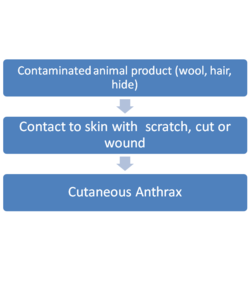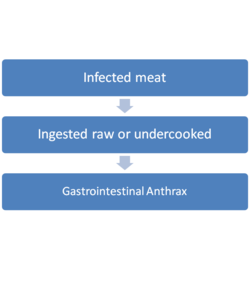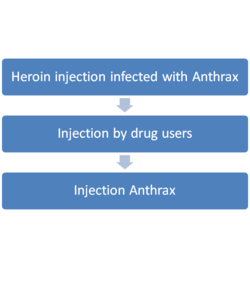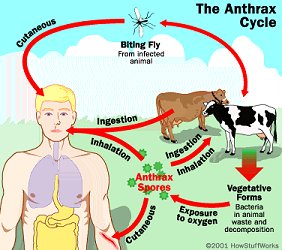Anthrax: Difference between revisions
No edit summary |
No edit summary |
||
| Line 64: | Line 64: | ||
=== Cutaneous Anthrax === | === Cutaneous Anthrax === | ||
Small blisters/ bumps | * Small blisters/ bumps | ||
* Swelling | |||
Swelling | * Painless skin sore (ulcer), most often the sore will be on the face, neck, arms, or hands<ref name=":0" /> | ||
Painless skin sore (ulcer), most often the sore will be on the face, neck, arms, or hands<ref name=":0" /> | |||
=== Gastrointestinal Anthrax === | === Gastrointestinal Anthrax === | ||
Fever and chills | * Fever and chills | ||
* Swelling of neck and lymph node enlargement | |||
Swelling of neck and lymph node enlargement | * Sore throat | ||
* Painful swallowing | |||
Sore throat | * Dysphagia | ||
* Respiratory distress | |||
Painful swallowing | * Oral bleeding | ||
* Hoarseness | |||
Dysphagia | * Nausea and vomiting or hematemesis | ||
* Diarrhea or bloody diarrhea | |||
Respiratory distress | * Headache | ||
* Flushing (red face) and red eyes | |||
Oral bleeding | * Stomach pain | ||
* Fainting | |||
Hoarseness | * Swelling of abdomen (stomach) | ||
Nausea and vomiting or hematemesis | |||
Diarrhea or bloody diarrhea | |||
Headache | |||
Flushing (red face) and red eyes | |||
Stomach pain | |||
Fainting | |||
Swelling of abdomen (stomach) | |||
=== Inhalation Anthrax === | === Inhalation Anthrax === | ||
Fever and chills | * Fever and chills | ||
* Chest Discomfort | |||
Chest Discomfort | * Shortness of breath | ||
* Tachypnea | |||
Shortness of breath | * Cyanosis | ||
* Confusion or dizziness | |||
Tachypnea | * Cough | ||
* Nausea, vomiting (hematemesis), or stomach pains | |||
Cyanosis | * Headache | ||
* Diaphoresis | |||
Confusion or dizziness | * Extreme tiredness | ||
* Body aches | |||
Cough | |||
Nausea, vomiting (hematemesis), or stomach pains | |||
Headache | |||
Diaphoresis | |||
Extreme tiredness | |||
Body aches | |||
=== Injection Anthrax === | === Injection Anthrax === | ||
Injection anthrax has almost the same manifestation as Cutaneous Anthrax except for it could affect deeper structures and can spread more easily.<ref name=":0" /> | Injection anthrax has almost the same manifestation as Cutaneous Anthrax except for it could affect deeper structures and can spread more easily.<ref name=":0" /> | ||
* Fever and chills | |||
Fever and chills | * A group of small blisters or bumps that may itch, appearing where the drug was injected | ||
* A painless skin sore with a black center that appears after the blisters or bumps | |||
A group of small blisters or bumps that may itch, appearing where the drug was injected | * Swelling around the sore | ||
* Abscesses deep under the skin or in the muscle where the drug was injected | |||
A painless skin sore with a black center that appears after the blisters or bumps | |||
Swelling around the sore | |||
Abscesses deep under the skin or in the muscle where the drug was injected | |||
== Diagnosis == | == Diagnosis == | ||
| Line 182: | Line 150: | ||
** Clindamycin | ** Clindamycin | ||
* Monoclonal Antibodies | * Monoclonal Antibodies | ||
** Raxibacumab- prophylactic agent and treatment | ** Raxibacumab- prophylactic agent and treatment of inhalational anthrax | ||
** Obiltoxaximab- | ** Obiltoxaximab- treatment of inhalational anthrax | ||
* Human anthrax immune globulin (Anthrasil)- indicated for treatment of inhalational anthrax in adults and children in combination with antibiotic therapy. | * Human anthrax immune globulin (Anthrasil)- indicated for treatment of inhalational anthrax in adults and children in combination with antibiotic therapy. | ||
* Anthrax Vaccine Adsorbed (BioThrax) | * Anthrax Vaccine Adsorbed (BioThrax)- indicated for pre-exposure prophylaxis in persons at high risk of exposure and for postexposure prophylaxis following suspected or confirmed ''B anthracis'' exposure. | ||
* Antitoxins | * Antitoxins | ||
=== Physiotherapy Management === | === Physiotherapy Management === | ||
| Line 194: | Line 161: | ||
=== Cutaneous Anthrax === | === Cutaneous Anthrax === | ||
Bubonic Plague | * Bubonic Plague | ||
* Primary Syphyilis | |||
Primary Syphyilis | |||
=== Gastrointestinal Anthrax === | === Gastrointestinal Anthrax === | ||
Dysentery | * Dysentery | ||
=== Inhalational Anthrax === | === Inhalational Anthrax === | ||
[[Pneumonia]] (Atypcial or Community- Acquired) | * [[Pneumonia]] (Atypcial or Community- Acquired) | ||
* Bacterial Mediastinitis<br> | |||
Bacterial Mediastinitis<br> | |||
=== Other Conditions: === | === Other Conditions: === | ||
[[Tularemia]] | * [[Tularemia]] | ||
* Typhoid | |||
Typhoid | * Diphtheria | ||
* Psittacosis | |||
Diphtheria | * Leprosy | ||
Psittacosis | |||
Leprosy | |||
== Resources == | == Resources == | ||
CDC- Anthrax | # [https://www.cdc.gov/anthrax/basics/index.html CDC- Anthrax] | ||
# [https://www.cdc.gov/anthrax/bioterrorism/index.html CDC- Anthrax Bioterrorism] | |||
[https://www.cdc.gov/anthrax/bioterrorism/index.html CDC- Anthrax Bioterrorism] | # [https://www.cdc.gov/anthrax/resources/index.html CDC- Anthrax Resources]- for additional readings | ||
[https://www.cdc.gov/anthrax/resources/index.html CDC- Anthrax Resources]- for additional readings | |||
== References == | == References == | ||
Revision as of 08:07, 2 April 2020
This article or area is currently under construction and may only be partially complete. Please come back soon to see the finished work! (2/04/2020)
Definition[edit | edit source]
Anthrax is an acute zoonotic disease caused by the spore-forming bacterium Bacillus anthracis, a microbe that lives in the soil.[1]
- A serious infectious disease caused by gram-positive, rod-shaped bacteria known as Bacillus anthracis.[2]
- Anthrax can be found naturally in soil and commonly affects domestic and wild animals around the world.[2]
- Rare in the United States - people can get sick with anthrax if they come in contact with infected animals or contaminated animal products.[2]
- Contact with anthrax can cause severe illness in both humans and animals.[2]
- Anthrax is not contagious, which means you can’t catch it like the cold or flu.[2]
- Anthrax can occur in four forms: cutaneous, inhalation, gastrointestinal, and inhalation.[2]
Clinically Relevant Anatomy[edit | edit source]
Anthrax can affect different body systems, depending on the route of infection. It can affect the integumentary system, gastrointestinal/ digestive system and respiratory system.
Etiology[edit | edit source]
The pathogen that causes Anthrax is a bacterium known as Bacillus anthracis.
Epidemiology[edit | edit source]
Most cases of anthrax are cutaneous (95%); the remaining cases are inhalation (5%) and gastrointestinal (< 1%).[3] Injection Anthrax have only been reported in Northern Europe.[2][4]
Incidence of any anthrax infection has been less than 1 case per year in the US for the last 30 years. From 1955–1994, US cases totaled 235, with 224 cases of cutaneous anthrax, 11 cases of inhalation anthrax, and 20 fatalities.[3]
Anthrax is common in Middle East, the Indian subcontinent, Africa, Asia, and Latin America and is rare in Western Europe. In 1958, approximately 100,000 cases of anthrax occurred worldwide. Anthrax is endemic in Africa and Asia despite vaccination programs.[3]
In 1978, during the Rhodesian civil war, failure of veterinary vaccination programs led to a human epidemic, causing 6500 anthrax cases and 100 fatalities.[3]
In 1982, Thailand had an outbreak of 24 cases, concurrently with 52 cases of cutaneous anthrax after ingestion of contaminated water buffalo meat.[3]
In October 2001, 22 cases of anthrax infection were identified.[3] Most recently in 2016, in Siberia, Russia, there was an outbreak of anthrax that affected at least 13 Siberian people and killed over 2,000 reindeer.[4]
Risk Factors[edit | edit source]
Occupational hazard for:
- Veterinarians
- Farmers
- Individuals who handle animal wool, hair, hides, or bone meal products.[3]
- Travelers
- Laboratory professionals
- Mail handlers, military personnel, and response workers who may be exposed during a bioterror event involving anthrax spores[2]
There is no racial, sexual, or age predilection for anthrax. However, because anthrax is often related to industrial exposure and farming, the disease most often affects young and middle-aged adults.[3]
Pathophysiology[edit | edit source]
Anthrax can occur in four different forms, depending on the route of infection.

|

|

|

|
When the spores get inside the body, from any route mentioned from above, the spores then become anthrax bacteria. Then the bacteria can multiply, spread out in the body, produce toxins (poisons), and cause severe illness. [2]
Clinical Presentation[edit | edit source]
Clinical manifestations usually happen 1-7 days after exposure from the spores.
Cutaneous Anthrax[edit | edit source]
- Small blisters/ bumps
- Swelling
- Painless skin sore (ulcer), most often the sore will be on the face, neck, arms, or hands[2]
Gastrointestinal Anthrax[edit | edit source]
- Fever and chills
- Swelling of neck and lymph node enlargement
- Sore throat
- Painful swallowing
- Dysphagia
- Respiratory distress
- Oral bleeding
- Hoarseness
- Nausea and vomiting or hematemesis
- Diarrhea or bloody diarrhea
- Headache
- Flushing (red face) and red eyes
- Stomach pain
- Fainting
- Swelling of abdomen (stomach)
Inhalation Anthrax[edit | edit source]
- Fever and chills
- Chest Discomfort
- Shortness of breath
- Tachypnea
- Cyanosis
- Confusion or dizziness
- Cough
- Nausea, vomiting (hematemesis), or stomach pains
- Headache
- Diaphoresis
- Extreme tiredness
- Body aches
Injection Anthrax[edit | edit source]
Injection anthrax has almost the same manifestation as Cutaneous Anthrax except for it could affect deeper structures and can spread more easily.[2]
- Fever and chills
- A group of small blisters or bumps that may itch, appearing where the drug was injected
- A painless skin sore with a black center that appears after the blisters or bumps
- Swelling around the sore
- Abscesses deep under the skin or in the muscle where the drug was injected
Diagnosis[edit | edit source]
Diagnosis is made through history-taking for possible exposure, evaluation of signs and symptoms, diagnostic procedures, and laboratory findings.
The Centers for Disease Control and Prevention (CDC) has resources that can help in diagnosing and investigating anthrax. These are:
Anthrax Case Investigation System
Anthrax Investigation Database
Diagnostic Procedures/ Laboratory Findings[edit | edit source]
- Gram Staining and Blood Culture
- Enzyme-Linked Immunosorbent Assay (ELISA)
- ELISA to detect immunoglobulin G (IgG) response to B anthracis protective antigen (PA) is 98.6% sensitive and 80% specific. Protective antigen–competitive inhibition ELISA is used as a second confirmatory step to improve specificity.[3]
- Chest Radiograph
- widening of the mediastinum,paratracheal and hilar fullness, and pleural effusions[3]
- CT Scan
- detects hemorrhagic mediastinal and hilar lymph nodes and edema, peribronchial thickening, and pleural effusions[3]
- Lumbar Puncture
- CSF in patients with anthrax meningitis is grossly hemorrhagic with few polymorphonuclear neutrophils (PMNs) and numerous gram-positive bacilli.[3]
- Histologic Findings
Outcome Measures[edit | edit source]
Management / Interventions[edit | edit source]
The CDC has a set of guidelines for the Prevention and Treatment of Anthrax.
Medical Management[edit | edit source]
- Antibiotics
- Penicillin- preferred agent used to treat nonbioterrorist anthrax
- Doxycycline
- Ciprofloxacin
- Levofloxacin
- Moxifloxacin
- Amoxicillin
- Vancomycin
- Clindamycin
- Monoclonal Antibodies
- Raxibacumab- prophylactic agent and treatment of inhalational anthrax
- Obiltoxaximab- treatment of inhalational anthrax
- Human anthrax immune globulin (Anthrasil)- indicated for treatment of inhalational anthrax in adults and children in combination with antibiotic therapy.
- Anthrax Vaccine Adsorbed (BioThrax)- indicated for pre-exposure prophylaxis in persons at high risk of exposure and for postexposure prophylaxis following suspected or confirmed B anthracis exposure.
- Antitoxins
Physiotherapy Management[edit | edit source]
Differential Diagnosis[edit | edit source]
Cutaneous Anthrax[edit | edit source]
- Bubonic Plague
- Primary Syphyilis
Gastrointestinal Anthrax[edit | edit source]
- Dysentery
Inhalational Anthrax[edit | edit source]
- Pneumonia (Atypcial or Community- Acquired)
- Bacterial Mediastinitis
Other Conditions:[edit | edit source]
- Tularemia
- Typhoid
- Diphtheria
- Psittacosis
- Leprosy
Resources[edit | edit source]
- CDC- Anthrax
- CDC- Anthrax Bioterrorism
- CDC- Anthrax Resources- for additional readings
References[edit | edit source]
- ↑ U.S. National Library of Medicine. National Institute of Health. Medline Plus. Anthrax.http://www.nlm.nih.gov/medlineplus/anthrax.html (accessed 2 March 2011)
- ↑ 2.00 2.01 2.02 2.03 2.04 2.05 2.06 2.07 2.08 2.09 2.10 CDC- Anthrax- Basic Information. Available at https://www.cdc.gov/anthrax/basics/index.html (Accessed March 30, 2020)
- ↑ 3.00 3.01 3.02 3.03 3.04 3.05 3.06 3.07 3.08 3.09 3.10 3.11 Medscape- Anthrax. Available at https://emedicine.medscape.com/article/212127-overview (Accessed March 31, 2020)
- ↑ 4.0 4.1 Medicinenet- Anthrax. Available at https://www.medicinenet.com/anthrax/article.htm#anthrax_facts (Accessed March 31, 2020)







